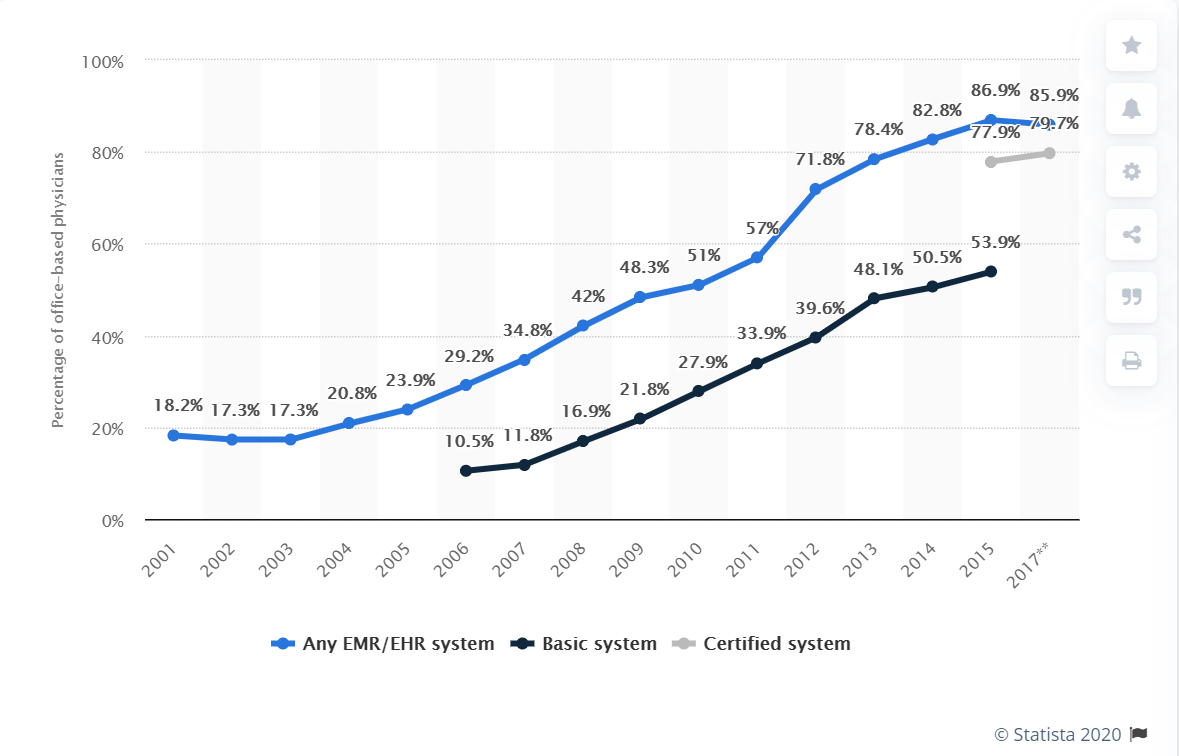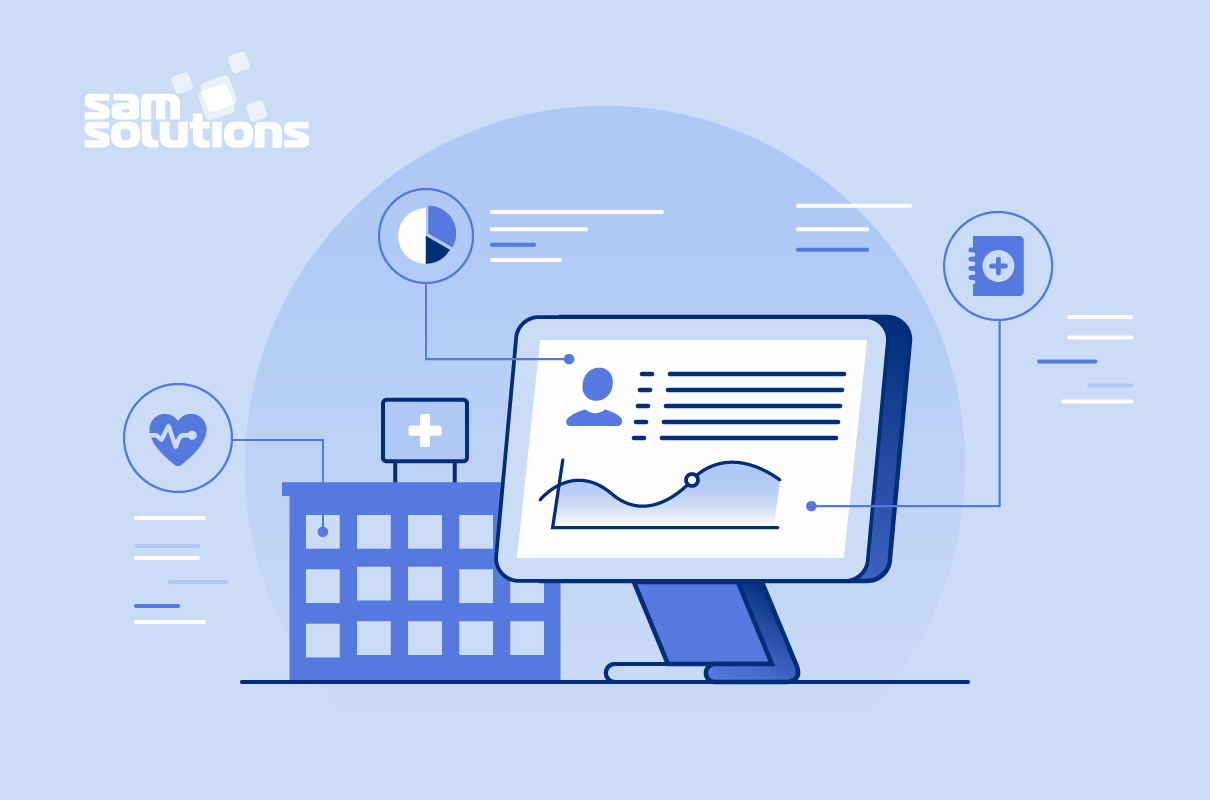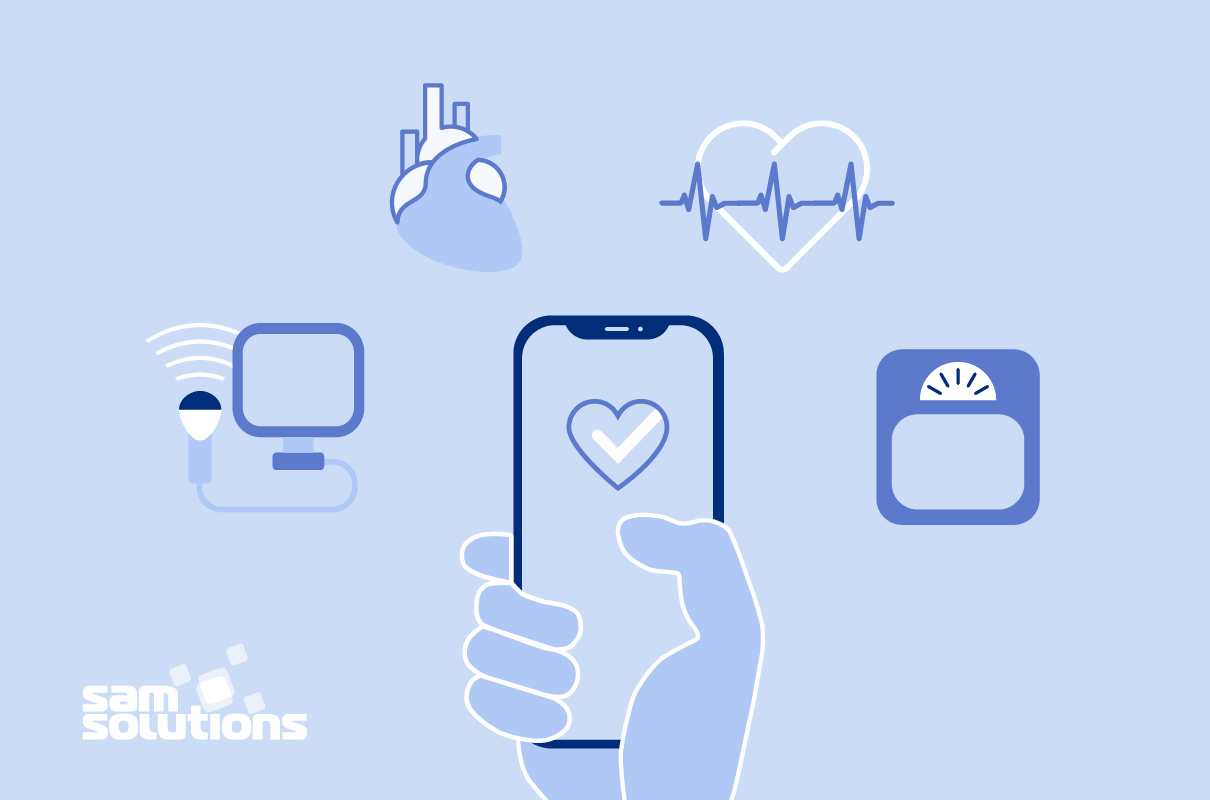The journey of healthcare to digitization is accompanied by a great number of innovative technologies, from IoT connected devices to VR simulator systems. Some have already been implemented in the medical practice and have changed it for the better, others are under development.
Medical software solutions take the leading position among the trends of digital transformation in healthcare. How to create a successful medical solution and benefit from it? Let’s see!
Develop your custom software with SaM Solutions’ engineers, skilled in the latest tech and well-versed in multiple industries.
Facts and Figures
Statistics show that there is a great demand for software development in healthcare.
The diagram below depicts a fantastic growth in the number of physicians who used electronic medical records or electronic health records from 2001 to 2017, which is, probably, the best evidence that such systems are highly effective for the doctor’s work.
Percentage of office-based physicians with EHR/EMR systems in the United States from 2001 to 2017

Source: Statista
Another diagram reflects the experience of adults in using health applications to track illness.
Percentage of U.S. adults who would be willing to use an app to track illness and medication as of 2017, by community

Source: Statista
The percentage of those who use this type of apps regularly is quite small — from five to six percent. But the number of people who are willing to use technologies for health monitoring is impressive and exceeds 60 percent. This means that patients are eager to engage in the treatment process and are open to innovations. Then all we need is to ramp up the healthcare software development.
Why Should You Build Healthcare Software?
Digital solutions make the medical system more personalized, turning it into any-time, any-place, continuous care. So, we are witnessing the creation of a new business model — a customer-centered digital healthcare ecosystem.
The goal of digital healthcare is to create a single information space of varying scalability, from a standalone clinical institution to a regional network, with the help of mobile app development, cloud computing, web and other technologies. Information systems and networks build a reliable connection between patients, medical consultants and healthcare providers, which is handy and beneficial for all the parties.
Benefits for Clinical Specialists
- Elimination of daily routine paperwork
- Easy management of practices via using electronic health records
- Seamless management of all processes in hospitals
- Enhanced collaboration with colleagues due to telemedicine even in spite of the geographical distance
Benefits for Patients
- The ability to make appointments and fill out documents remotely
- Easy communication with personal physicians via secure online channels
- Access to lab results and medical history via digital personal health records
- The additional educational information provided by experts on different issues
Benefits for Health Organizations
- Improved diagnostics due to reliable and comprehensive patient data and easy access to records
- Better coordination of processes because all the information is stored in one place
- Availability of communication tools
- Reduced costs due to the automation of numerous tasks
- Enhanced quality of medical services
- Increased patient satisfaction and engagement
These considerable benefits prove that every medical company, large or small, should make healthcare software to succeed in a highly competitive market.
Types of Medical Software
Modern clinical establishments are freed from excessive paperwork and can seamlessly manage numerous processes due to the different types of medical software. Let’s see what software is used by medical practices, in hospitals, and by patients.
Practice Management System
This is a customer relationship management (CRM) system for medical practices. The software integrates all clinical and administrative processes and helps users handle them more efficiently. As a result, the practice optimizes workflow, reduces the time and money expenses, and provides better patient care.
The practice management software may include various subcategories such as:
- A scheduling solution — patients can make an online appointment on their own via any mobile device, which simplifies a scheduling process and reduces phone traffic
- A billing solution — hospitals can automate all insurance claims and payment procedures
- An e-prescription solution — physicians send prescriptions directly to pharmacies in just a few clicks, saving time and eliminating mistakes that may occur because of unclear handwriting; moreover, the system keeps track of patients’ records and provision of medicines, providing a better level of protection
EMR
An electronic medical records (EMR) system is a digital alternative to an archive of paper documents. This is one of the most popular healthcare software that simplifies the routine work of physicians with documents.
Digital versions of patient histories are portable and easily accessible. A doctor can quickly check and analyze previous patient examinations and laboratory tests and, therefore, provide better diagnosing and treatment. The system can also remind of the due preventive procedures.
EHR
Electronic health records software (EHR) is similar to an EMR one, but it is more comprehensive. If data from EMRs can be shared only within one office, EHRs are able to transfer information to other clinical establishments and hospitals. It is vital in urgent cases when information from a patient’s health history is needed within a matter of minutes.
Patient Portals and Mobile Apps
Modern patients are eager to be engaged in the treatment process, be more educated and lead a healthy lifestyle. This is the point when telemedicine and digital health are getting in the game.
Specialized software such as patient portals and mobile apps are created to fulfill these desires and make healthcare more accessible and portable.
Patient portals provide various engagement tools:
- Online appointments
- Online consultations
- Online billing
- Feedback
- Educational information
Health mobile apps are divided into different types depending on their functions and target audience. For example, there are women’s health apps, programs that remind users to take pills or control the adherence to rehabilitation plans, apps with meditation manuals, consumption calculators and much more.
Guide on Creating Medical Software
How to build an EHR system, hospital management software or other digital solution for health organizations? As with any other type of software, there are numerous open-source ready-made solutions for different kinds of medical business. The examples are FreeMED, OpenEMR, One Touch EMR.
One size never fits all, and many companies opt to create custom healthcare software that can be perfectly tailored to their precise needs.
- One option is to use any of the open-source platforms, OpenMRS for instance, that enable agile development and customization of out-of-the-box solutions with little programming knowledge.
- Another option is to turn to an IT outsourcing company that can build a custom medical software from scratch.
The following algorithm depicts the most important steps that should be taken to make a customized healthcare project.
1. Define Your Target Audience

Prior to starting to develop custom medical software, you should clearly understand who your potential users are and what is of most importance to them.
An in-depth analysis of the target audience’s needs and desires will help both the customer and the vendor get a precise vision of the future solution. Therefore, it will be easier to decide on what features should be included and what technologies (virtual reality, cloud computing, Internet of Things, etc.) should be implemented.
When developers establish a strong connection with potential users, they are able to deliver a much better product.
2. Decide on Functional Structure

The structure of software always depends on its functions. As soon as you define what functions your application will perform, you can visualize its structure. Decide on what modules and submodules to create and how to connect them.
3. Design User-Friendly UI/UX

Medical software design is a critical stage of the development process. It’s impossible to create successful software without designing an intuitive interface, as it is the main tool of end-users. If this tool is complicated and not logical, users will shy away from it.
To create a consistent and easy-to-use solution, software engineers and designers collaborate to build a user interface (UI) and create a user experience (UX) based on end-customer expectations. Pay attention to choosing color schemes, fonts, the size of buttons, text alignment, icons and images.
4. Provide Data Protection

Collecting medical data through digital health technologies, as well as its storage and processing create huge risks of sensitive personal information leakage and cyber-attacks. Therefore, security assurance must be a priority.
Any type of healthcare software must comply with standards and requirements taken in the country or region it is produced and implemented. For instance, in the European Union, solutions must adhere to the General Data Protection Regulation (GDPR). Moreover, various methods and encryption techniques can be used to provide data protection.
Make sure that your vendor is able to develop an app with the appropriate security level.
5. Integrate with Other Systems

Integration with the legacy workflow is really important, as numerous documents or services should be kept and seamlessly transferred to the new system. Planning the integration process is a challenge: on the one hand, solutions should be compatible with other systems, on the other hand, the migration should be performed in such a way that customers won’t experience delays or downtimes.
Therefore, it’s important to include integration strategies in your development plan on the initial stage for synchronizing an app with a website, a clinic management system with accounting solutions, and so on.
Our Experience of Medical Software Development
One of our projects was related to the development of modular desktop software for managing and streamlining physiatrists’ daily operations with patient data and medical history.
As a follow-up, the customer decided to create a stand-alone mobile application to enhance and facilitate home examinations by the physiatrists. The app was required to increase doctors’ mobility and eliminate the necessity of taking documents with patients’ medical history to their homes. Another goal was to provide high-quality images, so the SaM Solutions team, together with the customer, decided on native software development, to leverage platform-specific graphics capabilities. Android and iOS were chosen as target platforms.
The application functionality:
- Synchronization and editing of patient data
- Addition of new medical exams
- The ability to take photos of injured body parts, or use system images if photos are nondiagnostic
Moreover, our team developed an add-on extension for occupational therapists that provides a set of functionality required for their work specifics.
What was the success? The software allowed doctors to reduce document flow and enhance the security of personal data. The customer received the mobile application that meets all business and technical requirements within a reasonable timeframe.
Now, the application is fully developed and available. Our team is still engaged in the project: we provide ongoing support and develop additional features upon customer request.
Tools & technologies used |
| Objective-C, Java, Cocoa Touch, CoreData, ReactiveCocoa, REST, ORM Lite, JSON, AFNetworking, Core Location, Android SDK, Android Studio IDE, Android VMb, uCrop, Retrofit. |
SaM Solutions provides offshore development for companies from different geographical regions and industrial spheres. If developing successful healthcare software is your ultimate goal, don’t hesitate to fill the contact form and get a consultation from our specialists.



















 The Latest 15 Information Technology Trends in 2024
The Latest 15 Information Technology Trends in 2024 Top 10 Embedded Software Development Tools
Top 10 Embedded Software Development Tools IaaS vs. PaaS vs. SaaS: What’s the Difference?
IaaS vs. PaaS vs. SaaS: What’s the Difference? 10 Examples of Predictive Analytics
10 Examples of Predictive Analytics








 13 Best React Development Tools in 2025
13 Best React Development Tools in 2025 Top 10 Mobile App Development Trends 2025
Top 10 Mobile App Development Trends 2025 Top IoT Industry Trends in 2025
Top IoT Industry Trends in 2025 Java Web App Security: Everything You Need to Know
Java Web App Security: Everything You Need to Know Top 10 Latest Trends in the Ecommerce Industry in 2025
Top 10 Latest Trends in the Ecommerce Industry in 2025
Firstly, I would like to thank sam-solutions from the depth of my heart. Because I was looking for something that is related to creating medical software. Finally, I found it and it’s really helpful for me. I learn a lot and gather informative knowledge as well.
I have to agree that the development of health care software is really beneficial to everyone especially the patients because they are able to have more accessibility in getting appointments, communication with specialists, and welfare education. Personally, I am rooting for these technological advancements since I could be a patient myself. It would be nice to think that companies are making more virtual ways for better health care systems to thrive.
No doubt, Medical Software are a boon to the Healthcare Industry. Thanks for writing this information.
A great piece that sheds much needed light on On-Demand Healthcare App Development Company and its impact on business as there are many new details you posted here.
I guess that the COVID-19 pandemic revealed numerous gaps and issues in the healthcare industry across the countries. And it triggered the development of medical software solutions for various purposes that will simplify doctors’ work.
It’s highly important to talk about healthcare problems and discuss the opportunities that can improve medical assistance.
Data protection is one of the critical tasks while developing software for healthcare organizations. Modern technologies can protect the highest level of data protection, so it’s time to develop and implement medical software in all clinics, hospitals and practices.
Medical software development should grow at a rapid pace globally. It’s so important to improve healthcare delivery, and software solutions are the best tools to do this.
Healthcare organizations need efficient software systems no less than other sectors. Automation of paperwork is vital for medical workers, as well as telemedicine is vital for many patients.
Thank you for your post. This is excellent information. It is amazing and wonderful to visit your site.